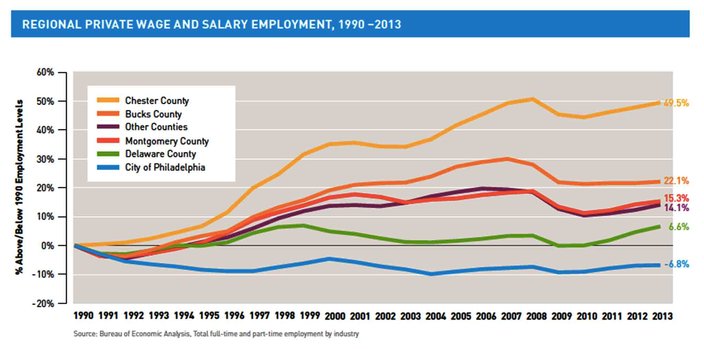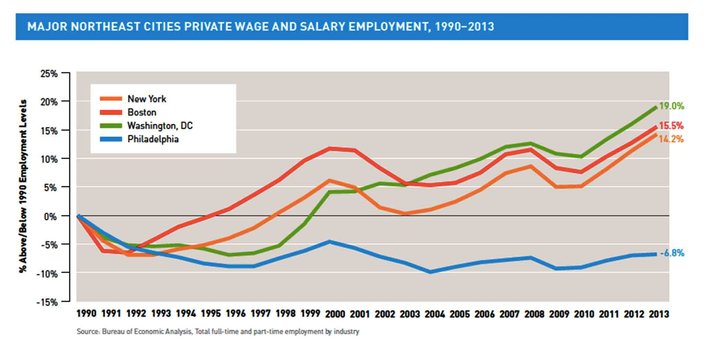The coterie of business, labor and real estate leaders that gathered Wednesday morning in Dilworth Park to announce the launch of the Philadelphia Jobs Growth Coalition’s tax reform campaign, left no doubt that the time is right for a change.
The city’s tax structure, they said over and over, is “antiquated” and detrimental to a healthy business climate.
“The best way to increase jobs in the city is to lower business and wage taxes. Only one other city in the United States depends on business tax for revenue and it’s, you guessed it, Detroit. [This system] is a predictor for decline.” – Paul Levy, executive director, Central Philadelphia Development Corp.
Their plan: to increase commercial real estate taxes by 15 percent to cover the costs of reducing the taxes that hurt small business and large corporations, and stop them from creating new jobs.
Cutting the wage tax to below three percent and halfing the net income portion of the Business Income and Receipts Tax (BIRT), they predict, will result in an increase of at least 50,000 additional jobs over the next decade.
First, they have to convince Harrisburg to change the State constitution — something that’s done all of the time but can take up to three years since proposals have to be passed by two consecutive legislative sessions.
Initial meetings have thus far been met very positively, Jerry Sweeney, president and CEO of Brandywine Realty Trust, one of the coalition members, told PhillyVoice.com.
In his prepared remarks, Sweeney noted that Philadelphia is still prey to declining revenues, anemic job growth, and relatively high unemployment — even as other rust belt cities are doing better. The culprit, he said, is an out-of-date tax structure that puts the onus on businesses and compels them to do business elsewhere.
Regional private wage and salary employment, 1990-2013 (Credit: State of Center City Philadelphia 2015 / Center City District + Central Philadelphia Development Corp.)
As a result, about half of Philadelphians reverse-commute to work in the suburbs, added Paul Levy, executive director of the Central Philadelphia Development Corp.
According to the CPDC’s State of the City 2015 report (
pdf), issued Monday, “between 1990 and 2013, Washington, Boston and New York City added respectively 19 percent, 15.5 percent, and 14.2 percent to their private sector [job] totals.”
So, Levy commented, job loss should no longer be viewed as a given fate of older cities. Except, that it is, in Philadelphia, where jobs decreased by 6.8 percent.
“We’re still on that path,” Levy told the audience. “The best way to increase jobs in the city is to lower business and wage taxes. Only one other city in the United States depends on business tax for revenue and it’s, you guessed it, Detroit. [This system] is a predictor for decline.”
The weak job market hurts not only ordinary Philadelphians, but also, conceded Levy, the power brokers who have joined the coalition. “No jobs means a low demand for office space, which means low rents, which means low tax revenues,” he said.
Major Northeast cities, Private wage and salary employment, 1990-2013 (Credit: State of Center City Philadelphia 2015 / Center City District + Central Philadelphia Development Corp.)
For businesses of any size, Levy told PhillyVoice.com after the event, the “increase in real estate tax [would be] more than offset by the reduction in the business income and receipts tax.”
Standing at the podium, Levy gestured toward the office towers surrounding City Hall and the park, noting that each one holds an average of 2,500 jobs — not just the employees of the companies that lease space, but the engineers, janitors, and the other building tradespeople who service them.
Levy then introduced several labor leaders, beginning with Daisy Cruz, Mid-Atlantic District Leader for SEIU 32BJ, which represents 10,000 property service workers in the Delaware Valley.
“Philadelphians should be able to work, live and play right here,” she said.
Jason Craparo was walking through the park with his wife, Laura, and their dogs and stopped to listen. The owner of a small mobile app development firm, Craparo, 30, is exactly the kind of person the city would like to attract to “work, live and play.”
In fact, he and his wife recently relocated here to be near her family. But, Craparo said, they’ve been surprised by how “it seems like everywhere you turn, you’re being taxed. Everywhere.”
He said the city’s business and wage taxes have made him hesitant to bring on more full-timers, forcing him instead to use independent contractors.
“I pay a few thousand every month in payroll taxes,” he explained. “That could add up to the salary of another two employees.”
Pat Eiding, president of the Philadelphia Council of the AFL-CIO, stressed that the Coalition’s message should be heeded not just by the people in the audience, but by the “folks who are going to be in the Mayor’s Office and City Council next year.
“It’s time for them to pull forth some intestinal fortitude and get behind a partnership that will give people in Philadelphia the opportunity to go to work,” he said.
Labor leaders John Dougherty (Electrical Workers) and Pat Gillepsie (Building Trades) also commented briefly; they were followed by Varsovia Fernandez of the Greater Philadelphia Hispanic Chamber of Commerce and Scott Bradley of the tri-state area’s African-American Chamber of Commerce.
Although the constitutional change may take time, it’s important to start getting the message out that “Philadelphia is open to business," Sweeney told PhillyVoice.com after the event. “It shows that we’re serious about removing the gating issues – the BIRT, the wage tax — that give employers pause when it comes to doing business here.”


